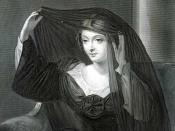William Shakespeare's Twelfth Night and John Webster's The Duchess of Malfi are fascinating plays with convoluted plots that cause the reader to ponder the possible differences of females roles in 17th century society versus the present day. This is what makes the plays so amazing and interesting, as good literature can easily invoke feelings in its reader, challenging personal morals and beliefs. " In early Modern England, both gender and hierarchy, with the man at the top, and the husband's patriarchal role as governor of his family and household - wife, children, wards, and servants - were assumed to have been instituted by God and nature" (http://www.wwnorton.com/nael/nto/17thC/family.htm). Shakespeare and Webster depict the attitude men display towards women, as males are seen to be the supreme rulers in the 17th century England. This is much different from the society today that has laws that prohibit gender discrimination, permitting women the same rights as men, therefore eliminating the difference in ways that women and men are looked upon.
As the reader divulges into the plays, the insight into the male-ruled world and the society's biased attitude toward gender brings about appreciation for the changed outlook that is present today. Both of the plays illustrate how men treat women as mere sexual objects and create circumstances that cause women to hide a part of their life. However, the writers also display some distinctions between the manners with which men tend to look upon women as Webster singles out females to be the only ones with a weak sense of reasoning; The Duchess of Malfi also demonstrates how males engage in violent schemes illustrating their need for control over women, while in Twelfth Night men do not abuse their power.
Initially, both of the works portray women as sexual objects of male desire.


